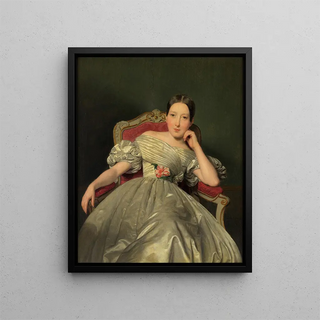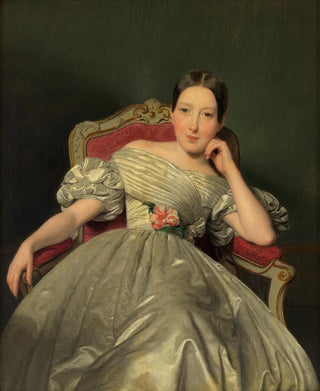Art print | Girl sitting in a white satin dress - Ferdinand Georg Waldmüller


View from behind

Frame (optional)
Art print of a seated girl in a white satin dress - Ferdinand Georg Waldmüller – Captivating introduction
The painting "Seated Girl in a White Satin Dress" by Ferdinand Georg Waldmüller is a work that transcends mere portraiture to capture a timeless essence of youth and beauty. Created in the 19th century, this piece stands out for its elegance and its ability to evoke deep emotions. The artist, renowned for his skill in depicting light and textures, transports us to a universe where every detail matters. The young girl, seated gracefully, appears to be both a muse and an observer of her own world, inviting the viewer to contemplate her intimacy while losing themselves in the delicacy of her satin dress.
Style and uniqueness of the work
Waldmüller is a master of realism, and this work is a perfect illustration of that. The soft light caressing the girl's face creates a serene, almost ethereal atmosphere. The choice of white satin for her dress is no coincidence; it symbolizes purity and innocence, while highlighting the artist's technical skills. The folds of the fabric, rendered with remarkable precision, reveal an in-depth understanding of how light interacts with surfaces. This portrait goes beyond simple visual rendering; it captures an emotion, a story, a life in the making. The girl's posture, slightly turned to the right, suggests introspection, a reflection on her identity and future, making the artwork all the more captivating.
The artist and his influence
Ferdinand Georg Waldmüller, born in 1793 in Vienna, is an emblematic figure of the Austrian Romantic movement. His career, marked by an incessant quest for truth and beauty, influenced many artists of his time and future generations. Waldmüller mastered impeccable technique combined with a unique sensitivity, thus standing out in the 19th-century artistic landscape. He often explored themes related to everyday life and human nature, seeking to capture fleeting moments of life. His ability to breathe soul into his subjects, as evidenced by the "Seated Girl in a

Matte finish

View from behind

Frame (optional)
Art print of a seated girl in a white satin dress - Ferdinand Georg Waldmüller – Captivating introduction
The painting "Seated Girl in a White Satin Dress" by Ferdinand Georg Waldmüller is a work that transcends mere portraiture to capture a timeless essence of youth and beauty. Created in the 19th century, this piece stands out for its elegance and its ability to evoke deep emotions. The artist, renowned for his skill in depicting light and textures, transports us to a universe where every detail matters. The young girl, seated gracefully, appears to be both a muse and an observer of her own world, inviting the viewer to contemplate her intimacy while losing themselves in the delicacy of her satin dress.
Style and uniqueness of the work
Waldmüller is a master of realism, and this work is a perfect illustration of that. The soft light caressing the girl's face creates a serene, almost ethereal atmosphere. The choice of white satin for her dress is no coincidence; it symbolizes purity and innocence, while highlighting the artist's technical skills. The folds of the fabric, rendered with remarkable precision, reveal an in-depth understanding of how light interacts with surfaces. This portrait goes beyond simple visual rendering; it captures an emotion, a story, a life in the making. The girl's posture, slightly turned to the right, suggests introspection, a reflection on her identity and future, making the artwork all the more captivating.
The artist and his influence
Ferdinand Georg Waldmüller, born in 1793 in Vienna, is an emblematic figure of the Austrian Romantic movement. His career, marked by an incessant quest for truth and beauty, influenced many artists of his time and future generations. Waldmüller mastered impeccable technique combined with a unique sensitivity, thus standing out in the 19th-century artistic landscape. He often explored themes related to everyday life and human nature, seeking to capture fleeting moments of life. His ability to breathe soul into his subjects, as evidenced by the "Seated Girl in a






